Sights and Sites of Industrial Transition.
By Mattias Malk
This photographic essay is a part of LABLAB’s “Countryside Unfolds” cross-disciplinary research project and explores the notion of industrial transition in the context of the Estonian countryside.
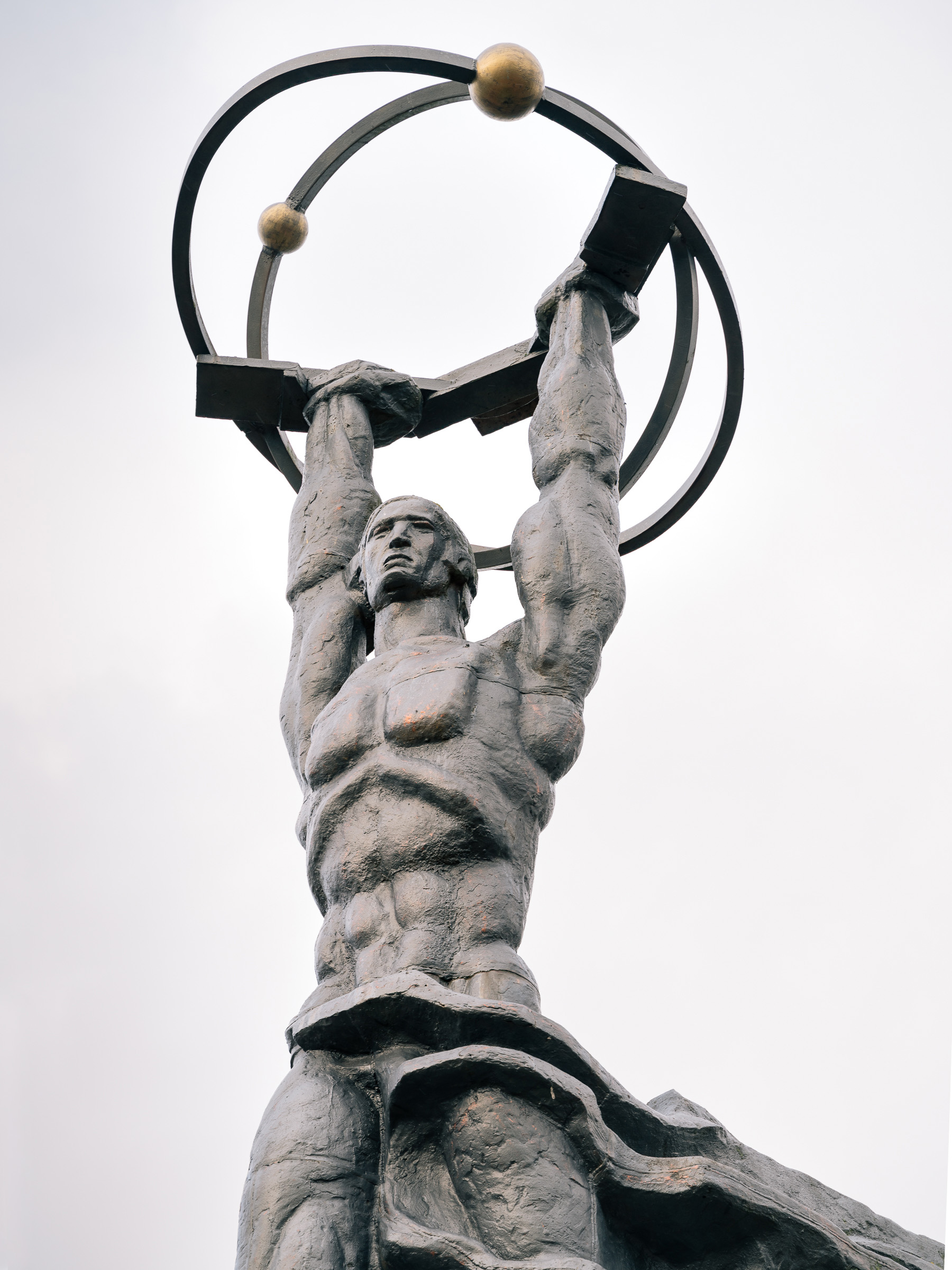

It does not attempt to holistically represent the process and makes no claims of totality. Rather it is a set of subjective views exploring a particular context of a “double periphery” in Eastern and Southern Estonia — distant from regional centres as well as the European core. It aims to challenge the systemic scholarly neglection of the rural in favour of the urban, which typically condemns industrialised and collectivised rurality to an inevitable downward spiral of shrinkage and deterioration. In truth, we have never been fully urban and rely intimately on the rural for resources and recreation alike. Instead of a passive bystander to urban ebbs and flows, the rural is alive with possibilities and prospects. Is there a way to perceive the city as the hinterland of the countryside instead?
This photographic essay reflects on this question and aims to contextualise some of the (counter-)processes of the urban-rural tug of war by focusing on transitional (post-)industrial landscapes in the peripheral secondary cities and countryside of Estonia. Some images seem to confirm primary prejudices: factories both in operation and abandoned as well as waste and empty housing. Other photographs hint at a more complex narrative of layered spatial adaptation, cultural- and recreational appropriation and everyday practices of living. Clearly, the meaning of rural life is changing. The question is what is it changing from and to as well as who has the ability to orchestrate these changes? Here concepts of the periphery, the idyll, reality, connectivity and local specificity are key.
The first session presents a monumental statue and two industrial landscapes. The first is a ten-meter tall free-standing monument at the entrance to the Baltic Electrical Power Plant in Narva, in the East of Estonia. The Icaros-figure stretches towards the sky welcoming workers to the grand complex. It glorifies Soviet positivism and romanticises work, the worker and industry. Without explicitly displaying the power plant itself, the pair of landscapes present the backdoor of the same complex—pairing labour enabled techno-optimistic narrative with the concrete outcomes of heavy industry. These landscapes of the alkaline pools formed as a result of the extractive industry. These turquoise lagoons stretch for kilometres within a stone’s throw of the Narva Reservoir, with its armies of leisurely fishermen and border guards. These neighbouring bodies of water require careful management for equilibrium. The result is a highly fractal landscape where the natural thoroughly meshes with the anthropogenic.
The second session features a single image from Valga, the South-Eastern border town between Estonia and Latvia. It catches a local inhabitant going about her shopping in the foreground and the industry of the city in the back. The road she is walking down leads to the informal centre of Valga, with its shopping malls and the market. Despite its notable admission of and progressive stance towards shrinkage, the question of housing, heritage and defining a new centre for the city remain sensitive topics. Valga, however, benefits from its historically advantageous location between spheres of regional influence in addition to the infrastructure of the railway. As a result, industry remains an active component of the urban fabric—part of the shift, not its subject.
This photographic essay reflects on this question and aims to contextualise some of the (counter-)processes of the urban-rural tug of war by focusing on transitional (post-)industrial landscapes in the peripheral secondary cities and countryside of Estonia. Some images seem to confirm primary prejudices: factories both in operation and abandoned as well as waste and empty housing. Other photographs hint at a more complex narrative of layered spatial adaptation, cultural- and recreational appropriation and everyday practices of living. Clearly, the meaning of rural life is changing. The question is what is it changing from and to as well as who has the ability to orchestrate these changes? Here concepts of the periphery, the idyll, reality, connectivity and local specificity are key.
The first session presents a monumental statue and two industrial landscapes. The first is a ten-meter tall free-standing monument at the entrance to the Baltic Electrical Power Plant in Narva, in the East of Estonia. The Icaros-figure stretches towards the sky welcoming workers to the grand complex. It glorifies Soviet positivism and romanticises work, the worker and industry. Without explicitly displaying the power plant itself, the pair of landscapes present the backdoor of the same complex—pairing labour enabled techno-optimistic narrative with the concrete outcomes of heavy industry. These landscapes of the alkaline pools formed as a result of the extractive industry. These turquoise lagoons stretch for kilometres within a stone’s throw of the Narva Reservoir, with its armies of leisurely fishermen and border guards. These neighbouring bodies of water require careful management for equilibrium. The result is a highly fractal landscape where the natural thoroughly meshes with the anthropogenic.
The second session features a single image from Valga, the South-Eastern border town between Estonia and Latvia. It catches a local inhabitant going about her shopping in the foreground and the industry of the city in the back. The road she is walking down leads to the informal centre of Valga, with its shopping malls and the market. Despite its notable admission of and progressive stance towards shrinkage, the question of housing, heritage and defining a new centre for the city remain sensitive topics. Valga, however, benefits from its historically advantageous location between spheres of regional influence in addition to the infrastructure of the railway. As a result, industry remains an active component of the urban fabric—part of the shift, not its subject.

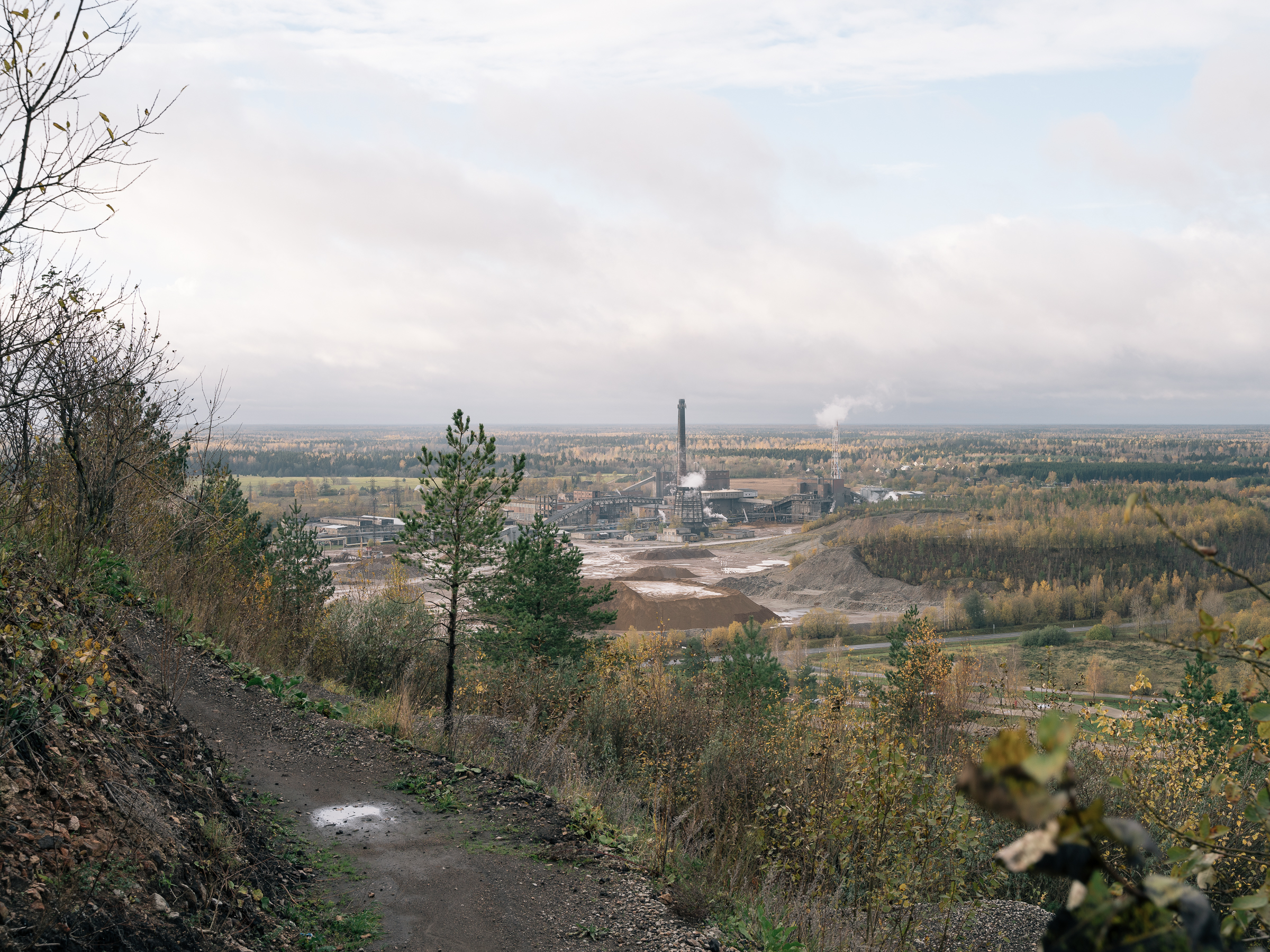
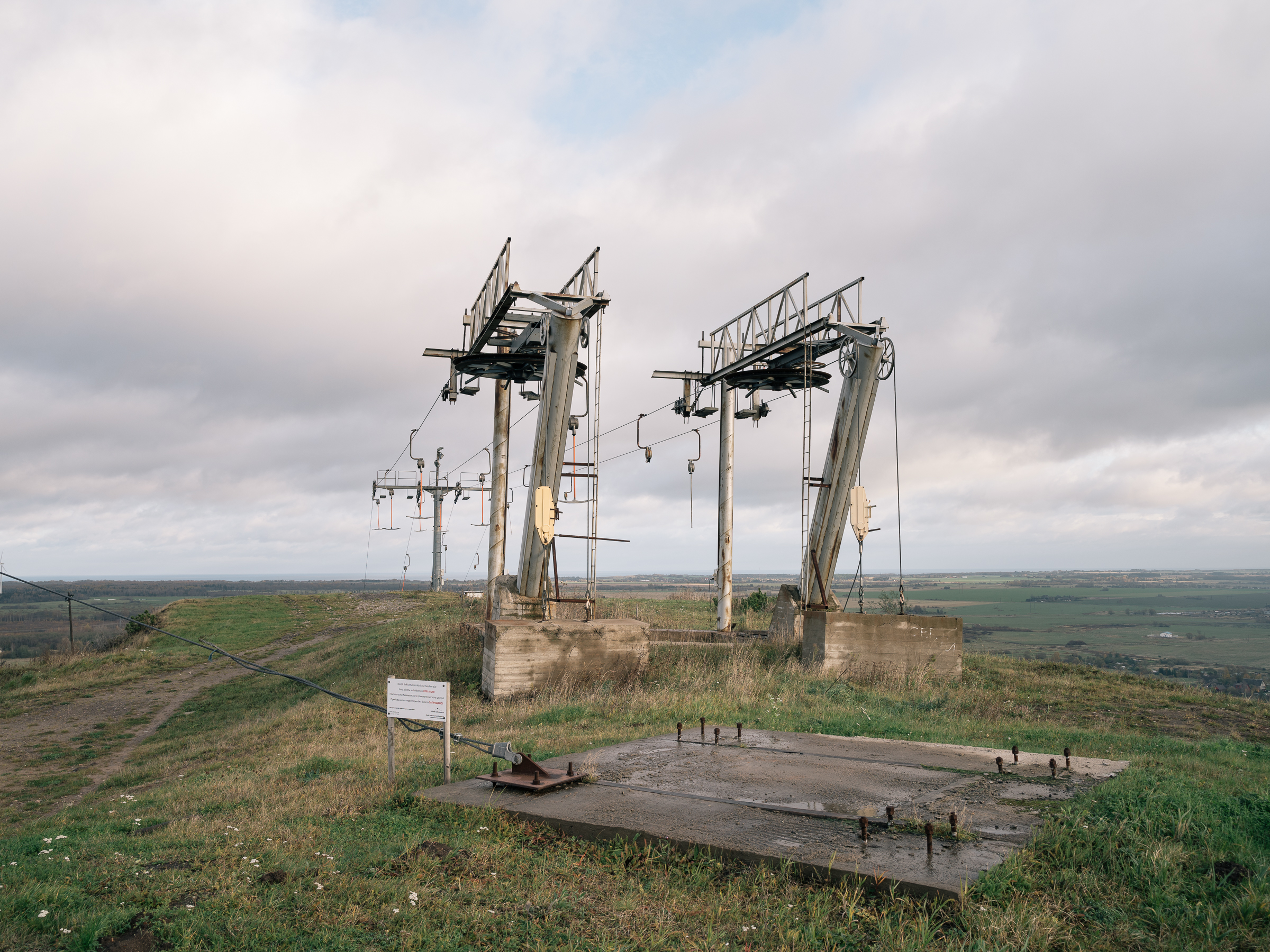


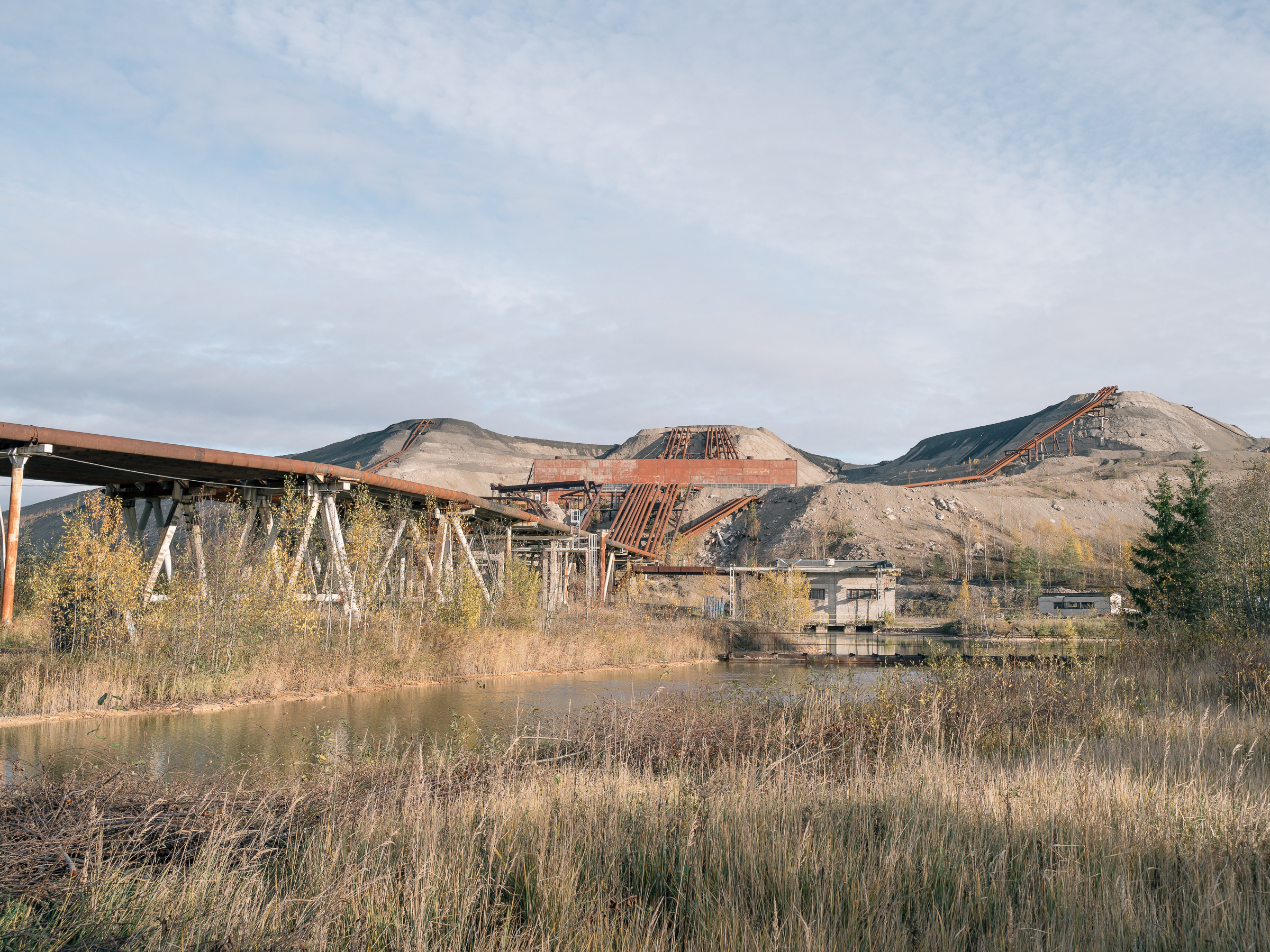
The third set jumps back to eastern Estonia. The images of the functional power plant and the ski lift are oppositional views from the same hilltop. Looking north, beyond the ski lift, fields and farmhouses stretch to the Baltic Sea. The southern view instead presents a landscape in formation by the same industrial processes which resulted in the mound the photographs are taken from. The hill has been reappropriated by locals for various recreational uses. Serviced by a hotel, it is part of rebranding Kiviõli as a site of regional tourism. The third image presents a counter-narrative from the heart of the adjacent city. The facade of the “khrushchevka” bears witness to the shrinkage strategies and the wider shift towards deindustrialisation in the city which takes its name from the stone oil it mines and processes.
The fourth session presents a second heroic figure of industry from the city of Sillamäe: the “Peaceful Atom”. The russian word for peace, “мир” also translates as “the world”. This duality is specifically significant to Sillamäe which was a closed city in the Soviet Union. Its strategic importance as a site of uranium extraction and refinery, meant the limits of the city enclosed it from the outside world. Inside, a total Stalinist central plan governed the urban fabric. The central promenade still cascades down the klint towards the sea. Surprisingly, the housing along its periphery has recently become heritage protected as an entire ensemble. Ironically, the local inhabitants prefer the khruschevkas for practical economic reasons, despite the state deeming Stalinist architecture more desirable.
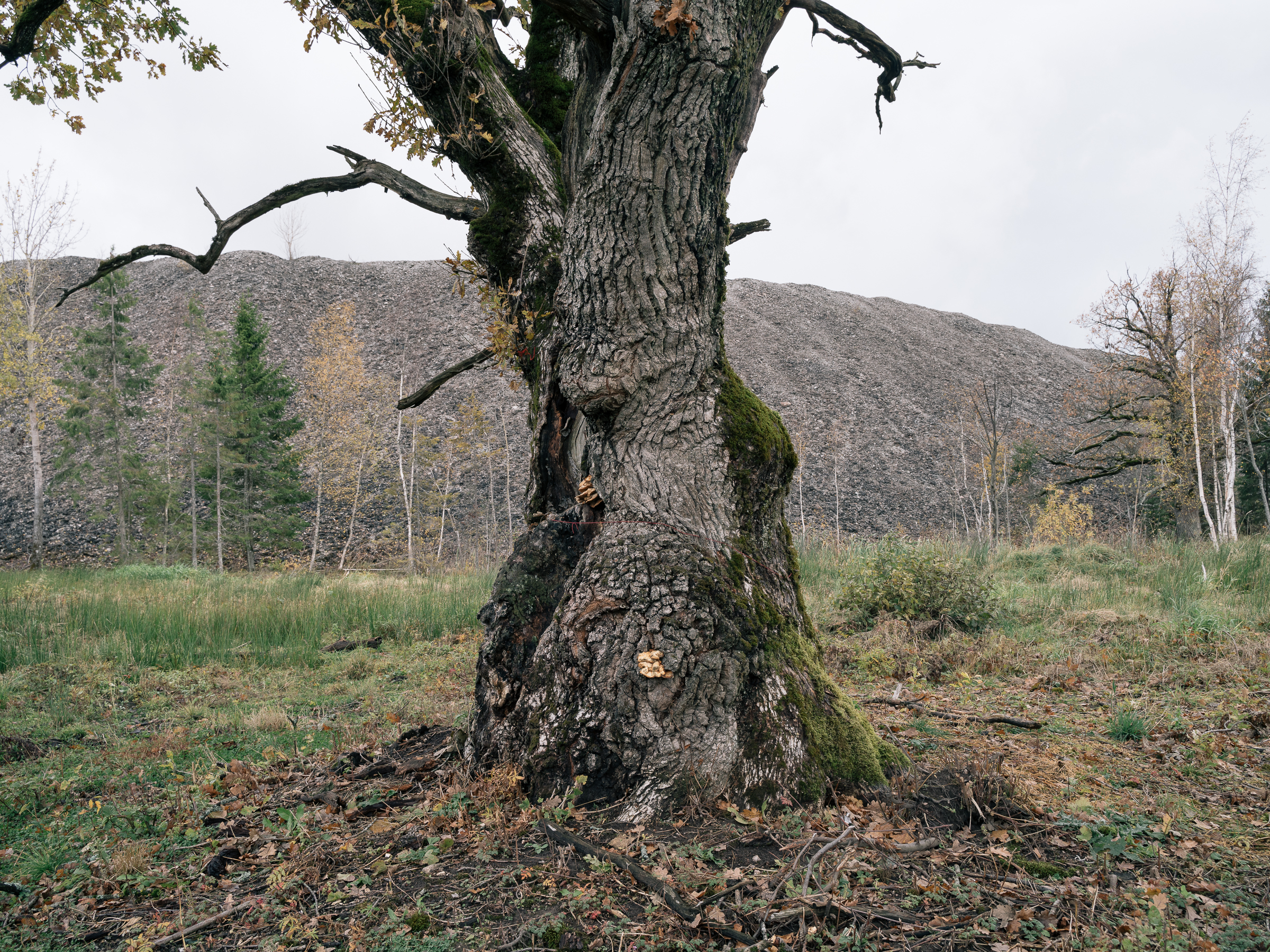
The final image stands slightly apart from the rest. The Hiiu Oak Grove is an ancient holy site for local animists. Trees, particularly grand oaks, are a key component of the historical estonian imaginary—literally rooted in pagan practices of land worship. This specific grove allegorically summarises the sentimental environmentalist view on extractive economy, particularly of the Soviet kind, as a destructive invasion of the otherwise “pure land” of rural Estonia. The oak seems about to be swallowed by the encroaching wall of regolith. An aerial view complicates this claim, however, as in addition to mining, the land all around is divided between monoculture fields, small settlements and the road network. It appears the grove is the aberration, not the other way around.
Mattias Malk is an urban researcher, PhD candidate and lecturer at the Estonian Academy of Arts. In his personal practice as well as work with Urbiquity, a platform for creative and critical urbanism, Mattias employs visual and narrative methodologies alongside traditional means of doing urban research.
This photographic essay was conducted in the fall of 2020, but first published in September 2021.
LABLAB
ROSENLUNDSGATAN 38
118 53 STOCKHOLM